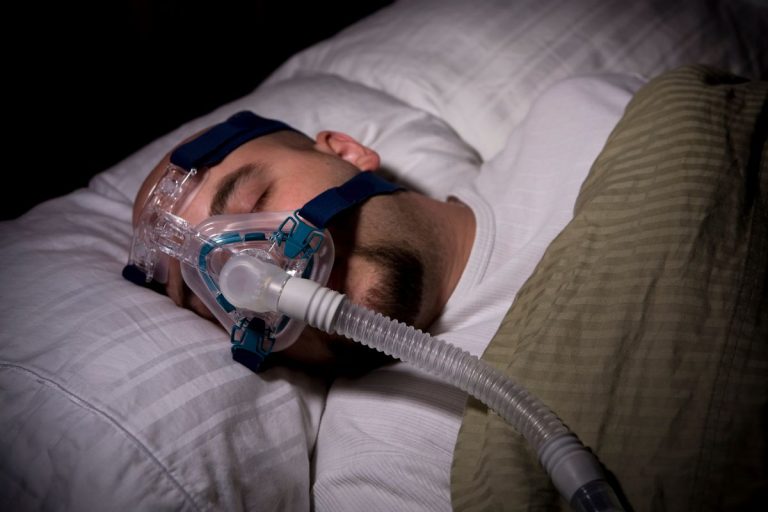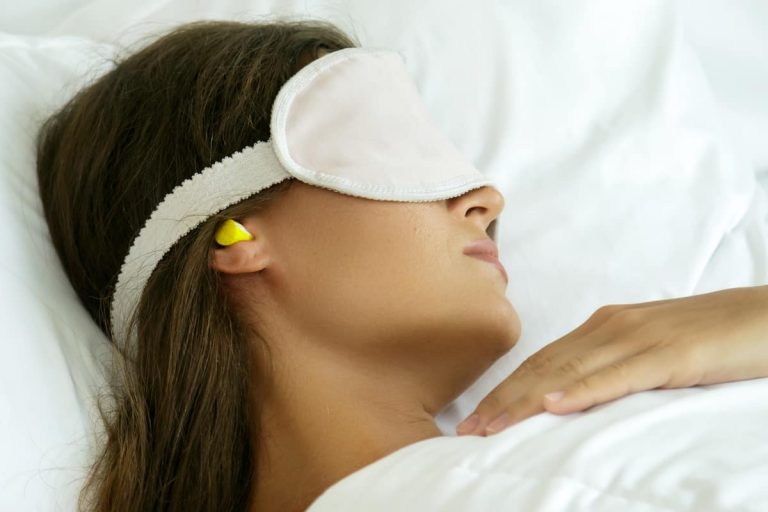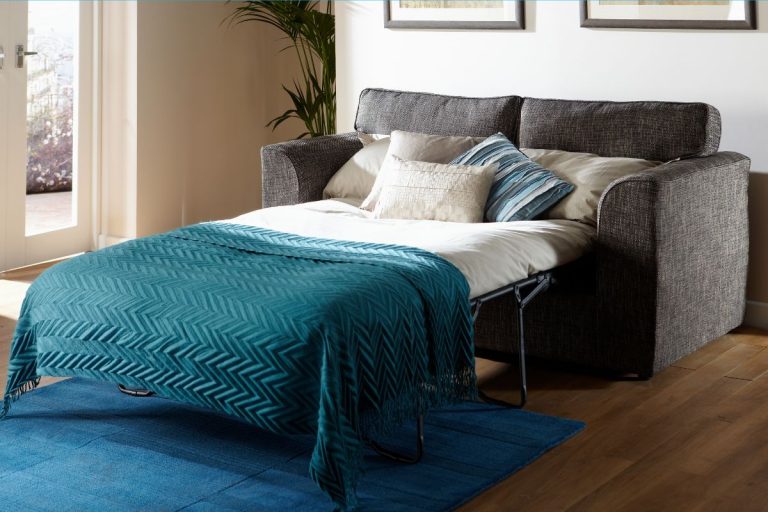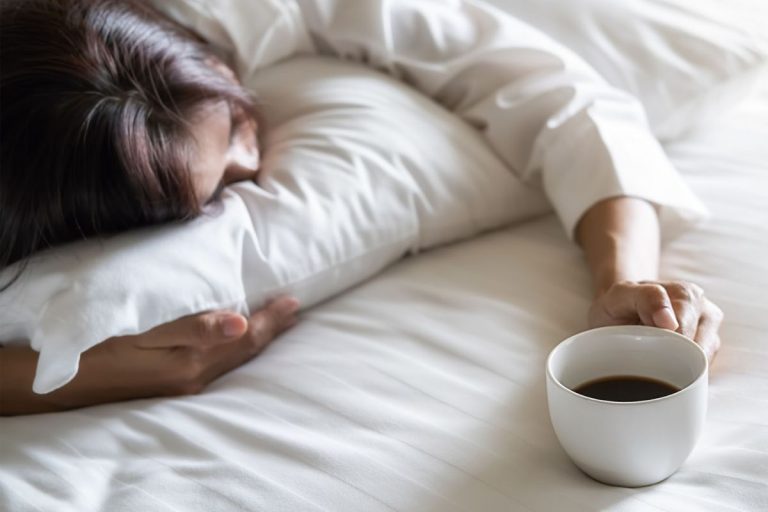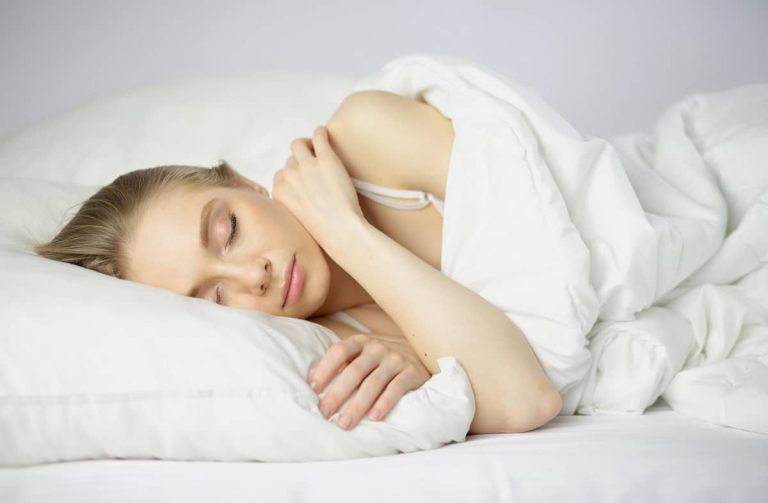Obstructive sleep apnea has become a fairly common disorder. It is believed that approximately up to 7% of the population experiences obstructive breathing disorders like OSA.
If left untreated, the condition can evolve into high blood pressure and heart diseases.
Luckily, when discovered and treated on time, sleep apnea can be managed and even treated completely. But, the problem lies in the fact that many people don’t even know they have sleep apnea. And even if they suspect, getting a test or polysomnography can be rather costly. That is why many seem to consider the home test option.
Therefore, in the following paragraphs, we’ll let you know everything about home sleep apnea tests, how they work, and what we recommend if you want to try the test yourself.
Home Sleep Apnea Test – Explained
What Is A Home Sleep Apnea Test?
The home sleep apnea test is used for the diagnosis of obstructive sleep apnea. The OSA home test is a convenient way to get a test and diagnosis in the comfort of your own home, which is rather convenient in the current times of coronavirus. Some people want to avoid going to the doctor to prevent getting infected, while others simply want to avoid the high costs of getting polysomnography.
The home sleep apnea test is conducted by you; there is no doctor or medical assistance or a sleep technician to administer the test. The test is conducted using one of the sleep apnea testing devices (portable breathing monitor kit), which you can get by consulting with your doctor or physician.
More to know: Two Types of Sleep Apnea: Obstructive and Central
How Does One Perform The Home Sleep Apnea Test?
Because the home test is a simplified version of the in-lab test, one can easily perform the sleep apnea test on their own.
After consulting with your physician, you should be prescribed a portable breathing monitor kit, which you can take home. For the proper testing and test results, you should;
- Read the test instruction thoroughly
- Ensure that the breathing monitor kit is properly set up with the monitoring sensors
- Sleep using the home sleep test equipment for several nights (often 3 nights)
- Gather the data for your doctor’s assessment
- Return the portable breathing monitor device
- Wait for the doctor’s assessment and report
- Discuss the results and consider future steps in case the results indicate a sleep apnea diagnosis
Patients are often prescribed an at-home sleep apnea test in the following cases;
- They suspect to have OSA
- They have a significant comorbid medical disorder
- They have a comorbid sleep disorder
- They suspect to have nocturnal seizures, nocturnal arrhythmias, and hypoventilation
- They are on opiates, etc.
Note: After a patient performs a home sleep apnea test, and they are positive for OSA, they often get treatment or are prescribed for polysomnography. The home test is positive if it shows prolonged, sustained hypoxemia, central apneas, or mixed apneas. In such cases, polysomnography is required for a more accurate depiction of the condition and the required treatment options.
How To Prepare For A Home Sleep Apnea Test?
Once you’re prescribed a home sleep apnea test, you need to start to follow some rules to properly prepare for the test. To get the best and most accurate results, we recommend;
- Avoiding alcohol and caffeine – both of the substances can aggravate your sleep apnea and disrupt one’s sleep regardless of the condition. Caffeine will make you feel more awake and make it difficult for you to fall asleep. Alcohol, on the other hand, may help you fall asleep faster, but it will promote frequent awakenings throughout the night, as well as disrupt usually normal metabolic functions. If you do have to consume caffeine, try to do it before lunch. The same goes for alcohol, but we recommend you skip drinking for at least a few days, while the test lasts.
- Avoiding napping after 3 pm – even though naps can be a great way to compensate for the lack of sleep, they can also disrupt your sleep-wake cycle and promote nighttime wakefulness. So, during the period of the sleep apnea test, try to avoid napping after 3 pm, or avoid it completely until the test is done.
- Sleeping on the back and the sides – for the test to show accurate results, you need to try sleeping on your back and sides. Sleeping on the back may seem counterintuitive since this sleep position aggravates sleep apnea. Side sleeping as well can either cause sleep apnea or aggravate it. Because the purpose of the test is to not only see whether you have sleep apnea but also how bad it is, these sleeping positions can help get the most accurate depiction of your OSA status.
Advantages And Disadvantages of The Home OSA Test
Just like everything in like, the home sleep apnea test has a set of advantages and disadvantages. Before you decide this test is the best way for you to determine whether you have a sleep problem or not, make sure to consider the pros and cons of the home test;
Advantages
- Convenience – the home test is more convenient than the lab tests, especially during the ongoing coronavirus pandemic when you want to stay away from hospitals and clinics as much as you can. Moreover, the test is convenient because you may sleep more normally than during the lab testing, since you’re at your own home, following a sleep routine that might show more accurate results.
- Less expensive – compared to the in-lab tests, the at-home test maybe even up to 20% less expensive. The at-home tests require less equipment, don’t require a doctor or physician assistance, and overall offer some DIY testing options, unlike the in-lab tests. In some cases, the at-home test is even covered by insurance.
- Fast results – unlike in-lab testing, the at-home test provides much faster results. The reason for that lies in the portable breathing monitor, which you take home and may start the monitoring that very night. In a few days, you can return the device and your doctor can immediately study the results and come up with a diagnosis or further testing options.
- Accessibility – not everyone lives near a hospital and a clinic. So, going for an in-lab sleeping test may be a difficult option to follow. That is why at-home testing is more accessible and more realistic for the majority of people. In some cases, the monitoring device can be even sent or returned by mail, so some patients don’t even have to go to the hospital or clinic.
Disadvantages
- Accuracy issues – it is known to home sleep apnea test may not detect all the problems and show accurate results. In the majority of cases, they are not reliable because there is no doctor or a sleep technician to follow the testing process. Because of this, at-home testing can skip some health conditions related to obstructed breathing and sleep, which may be potentially dangerous.
- Often lead to in-lab testing – the majority of at-home tests further require in-lab testing. This may be an option regardless of the test results. Even if you get a sleep apnea diagnosis right away, you may still need to undergo in-lab testing, so that the doctor determines proper treatment and therapy options.
- Limited testing options – at-home sleep apnea tests only focus on detecting sleep apnea, and not other sleep disorders. This can make it hard for the doctor to get a proper insight into the situation, and of course, to come up with a proper diagnosis. Often, because of this alone, doctors need to prescribe in-lab testing for more accurate situation analysis.
Home Sleep Apnea Test Results – Explained
After you’re done with the home test, you’ll return the device to your doctor for the result analysis. The way the test results are analyzed are as follows;
- The doctor will use the Apnea-Hypopnea Index (AHI) to diagnose obstructive sleep apnea. AHI is a measurement scale used to identify the number of apneas (lapses of breath) occurring every hour of sleep. In people with mild sleep apnea, there are up to 5 apneas occurring every hour of sleep. However, in people with severe sleep apnea, there are between 25 and 30 apneas per hour of sleep. I these cases, further lab testing is required.
- The doctor will continue reviewing your oxygen levels. If the oxygen levels are lower than the average, chances are sleep apnea is the main cause. In such cases, further lab testing is required.
- The doctor will advise repeating the test in case the results are unclear or suspected to not be accurate. That is also recommended in case the symptoms continue but there is no sleep apnea diagnosis. Some doctors, in such cases, skip the home test and recommend an in-lab test right away.
Home Sleep Apnea Test – FAQs
How Do I Get The Home Test?
Upon consulting with your doctor, you should be prescribed a portable breathing monitor device. You can even get the device at sleep centers, sleep study companies, and diagnostic agencies.
How Long Does The Home Test Last?
It should take approximately 3 days for the test to provide reliable results. It is recommended people use the test equipment for 2 to 3 nights, not more than that. The results should be enough for the doctor to come up with a diagnosis, or recommend further testing.
How Much Does The Home Test Cost?
The cost of a home sleep apnea test can vary between $150 and $500, depending on the equipment. However, in the majority of the cases, the equipment is covered by insurance. But, to get the insurance privilege, the patient needs to have the symptoms and need the status of ‘medical necessity’, in order to get the device without paying. Insurance companies like Blue Shield, Blue Cross, and Medicare usually cover home sleep apnea tests.
Who Should NOT Get A Home Sleep Apnea Test?
Not everyone is a suitable candidate for a home test. Here’s who should not get a home test for sleep apnea;
- People who are not at risk of developing obstructive sleep apnea
- People who are suspected to have another sleep disorder
- People who have pulmonary diseases
- People who have neuromuscular diseases
- People who have congestive heart failure
Where Can I Buy A Home Sleep Apnea Test?
Home sleep apnea tests are generally prescribed by the doctor and often covered by insurance. Therefore, these tests don’t have to cost you anything, in the right circumstances (which means your doctor needs to give you a status of ‘the home test being a medical necessity’, to get the insurance privilege.
However, you can, in fact, buy your own home sleep apnea test in case you suspect to have OSA, but want to avoid the visits to the doctor, etc. Here are some of our top recommendations;
- Apnitest Home Sleep Apnea Test Diagnostic Machine (HSAT) – the Apnitest might be one of the best and most reliable home sleep apnea tests. It is designed to provide accurate results of OSA testing, quickly and painlessly. The device simply monitors your sleep activity and gathers information in regards to possible sleep apnea. Once the testing is done, you can use the device-gathered info to consult with your doctor about the possible need for a CPAP or BPAP solution. The device provides an auto-generated report, providing AHI, RDI, and ODI information based on true sleep time. This improves the accuracy of the home test by up to 20%.
- Singular Sleep Home Sleep Apnea Test Kit – another reliable and hassle-free home sleep apnea test that comes from Singular Sleep. This device is one of the best devices on a market, and according to the users, one of the most accurate and reliable ones as well. The test doesn’t require a prescription, and it will take as few as 3 days to provide the results. After you’re done with the test, all you have to do is put the kit in the provided envelope, send it, and get results by email within 2 to 3 business days. Compared to how expensive the in-lab testing is, this home test is cost-friendly, at only $265, as it is currently on sale.
- Low T Sleep Center At-Home Sleep Apnea Test – if you’re looking for a home sleep apnea test that will provide overnight results, we recommend you check out the Low T Sleep Center home test. This test comprises a small, lightweight, and easy-to-use device, which provides highly accurate, overnight results. The test is actually a disposable, single-use test, which you only wear for one night, and dispose of it in the morning. The test is designed to detect heart rate, peripheral arterial tone, body position, oxymetry, snoring, and chest motions. These are all the different factors of sleep apnea, so you can expect to get a proper report for your doctor to study.
Final Thoughts
If you do suspect to have sleep apnea, make sure to consult with your doctor as soon as possible. If left untreated, sleep apnea can cause numerous other conditions, which can even be fatal.
If you do experience frequent awakenings during the night, or you find yourself gasping for air during sleep, make sure to see your doctor and talk about your symptoms, and seek help.
More to know about sleep apnea:

